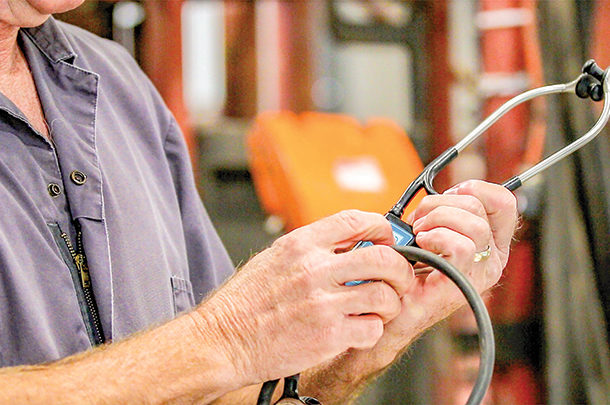Fall-weaned calves are once again filling the feedlots, bringing with them their stresses, susceptibilities and weakened immune systems. Spurred on by the newly acquired bugs of commingled calves, their depression or lack thereof will soon force operators to select a suitable option to address the oncoming health crisis.
Using metaphylaxis as a patch
One such option is the use of metaphylaxis, or mass treatments of animals. While some groups of calves seem to dodge the sickness bombardment entirely, and others escape with only the assistance of treatment drugs, some pens fall to pieces.
Dr. Brian Vander Ley, University of Nebraska – Lincoln assistant professor and veterinary epidemiologist, believes metaphylaxis use is a necessary patch, as so many cattle are compromised. “You get weaning stress coupled with commingling stress, coupled with the physiologic stress associated with the change in diet and environment. Plus, some may require common medical procedures such as castration or dehorning, and usually there are transportation stresses on top of everything else.”
He says the seven- to 10-day buffer provided by a metaphylaxis treatment buys the calves time to figure out where the food is, get rehydrated and kick-start their immune system to resist the bugs in their system. “When they finish this buffer, if things go as planned, instead of being susceptible they are actually on the recovered side, without ever going through the disease.”
Dr. Brad White, DVM, professor at Kansas State University’s College of Veterinary Medicine, says what makes the situation even more complex is: These animals don’t want anyone to know they are sick. “Metaphylaxis can help if we think a large portion of a group are ill, but we don’t know. If we did know exactly which ones were sick or going to be sick in the next four or five days, we could treat just them.”

In the original Whisper stethoscope model, lung sound recordings were analyzed and scored to identify calves needing treatment. It has since been joined by an updated version aimed at evaluating the lungs of inbound calves. Photo courtesy of Merck Animal Health.
He says it’s difficult to look at specific animals and decide which will be more susceptible. “Bovine respiratory disease [BRD] is a syndrome, and there are multiple pathogens, but there are also multiple risk factors influencing the calf’s susceptibility. We can’t evaluate in a vacuum, ignoring all the aspects of how the cattle were managed.”
What can and can’t be done?
Vander Ley emphasizes factors such as pre-weaning management, previous vaccination protocols, origin of backgrounding and size of the originating operation are pre-determined and can’t be modified after the fact. “These factors will necessitate grouping with animals from different sources,” he said. “But commingling is a huge component of respiratory disease.”
There are also controllable influences. “The degree of stress imposed by sorting practices, penning strategies, arrival procedures, group sizes, vaccinations and who they end up being housed beside are all good targets for leveraging improved health. The challenge is taking susceptible cattle to a resolved or recovered state without putting them through severe illness or, of course, death. Essentially, it’s about biocontainment.”
Technology options for the feedlot
Jenna Funk, DVM and associate veterinarian with Metzger Veterinary Services in Linwood, Ontario, says there are technologies in place or coming online attempting to reduce metaphylaxis by identifying BRD-susceptible calves.
She says these technologies are split into detection and confirmatory categories. “Detection tests occur in the home pen to find the sick animal, and the confirmatory test is done chuteside to determine whether an animal truly has BRD.”
The most common combination of detection and confirmatory tests for clinical evaluation is typical pen riding. But numerous trials have demonstrated this appraisal isn’t good enough, with numbers indicating only 60% of BRD cases are caught in the pens.
She says companies such as GrowSafe and Zoetis have targeted pen status with electronic feed intake monitoring systems. “We know, just like sick people, sick cattle eat less. It’s usually a sign they’re not well. But these technologies are still fairly expensive to implement.”
A second group targets confirmations chuteside. They include lung ultrasounds to scan the lung surface for damage. This procedure works better in younger and lighter animals, as the portion of the lung required for scanning becomes hidden beneath the front shoulder as cattle grow. For this reason, feedlot use is limited.
Funk believes the Whisper stethoscope, created by veterinarians in western Kansas and owned by Merck Animal Health, is promising. In the original model, lung sound recordings were analyzed and scored to identify calves needing treatment. It has since been joined by an updated version aimed at evaluating the lungs of inbound calves.
Additional technologies are test serums, blood samples and nasal secretions using equipment such as mass spectrometers to uncover changes associated with BRD. “We know there is some difference in blood and nasal secretions between sick and healthy calves. Research is being done but has a way to go before it’s really chuteside applicable.”
What can operators expect in the future?
White believes these technologies will continue to be explored and improved. “There are some giving us insight into what’s going on right now, but they don’t tell us what’s going to happen in three to five days,” he says. “Presently, I haven’t seen a single technology doing everything we want, but I think we’re getting closer.”
He says some chuteside technologies are helping to avoid the error of saying animals are sick when they’re not, which is good from an antibiotic use standpoint, but he hopes we’ll see technologies progress to where calves that don’t look sick can be identified.
Metaphylaxis is still an option for feedlot operators, but they can also employ practical means of stopping the creation of epidemics or controlling the spread of sickness. Additionally, improving pen and chuteside technologies are coming into play.
“We have to make the best decisions we can and take into account the trade-offs that may be present,” says White. “We want to use antimicrobials as judiciously as possible, but we need to balance this part of the equation with the animal welfare of the group. Part of that job is keeping as many animals healthy as possible.”











